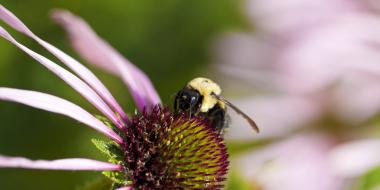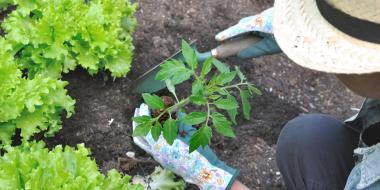I love harvesting food from my garden but sometimes the upkeep of a veggie patch can be a bit painstaking. To reduce the harvesting effort, I also make sure to include perennial foods and native edible plants in my garden and spend the season happily foraging the tasty ‘weeds’ that plant themselves wherever they like (not to mention picking the wonderful wild weeds that are great to eat!). Growing your own forage garden means that you can snack while out playing or doing chores. The kids will love freely nibbling on tidbits found thriving in and around your yard, too! The plants featured below are easy to care for, grow in most soil conditions, and are edible most of the growing season. So, grow wild!
Sweet Cicely
Myrrhis odorata

Kids love the unripe candy-like green seeds of Sweet Cicely with their sweet anise/licorice taste. The delicate fern-like leaves are quite pretty and are a flavourful addition to fruit or veggie salads, stewed rhubarb or other tart fruits, and savoury dishes. The leaves can be harvested all season long but have less flavour after the plant flowers. The root can also be harvested and used raw or cooked. Sweet Cicely grows about three feet tall and does well in full sun to partial shade, spreading readily by seed, and makes a great ground cover. If you want to keep its spread in check, encourage your kids to eat all the seeds before they ripen! The tiny umbelliferous (umbrella-like cluster) flowers of Sweet Cicely are great for supporting pollinators in your neighbourhood.
Forage hack: Kid approved! Cut a section of the stalk between two nodes for an instant, fully biodegradable straw that adds a slight licorice sweetness to your drink.
Sorrel
Rumex acetosa

Sorrel is a leafy green that has a tart, lemony taste. Deliciously snackable, my kids love nibbling on the leaves while they are out and about in the yard, and often invite our neighbours over to do the same! The tartness in the sorrel is caused by oxalic acid, which is fine in small amounts but shouldn’t be eaten in large quantities (cooking reduces the amount of oxalic acid). Sorrel is high in vitamin A and contains calcium, phosphorus, potassium, magnesium, iron and vitamin C.
So, snip sorrel up into salads with a mix of whatever else is coming up in the yard! Try your hand at sorrel soup or make a simple sorrel-cream sauce to drizzle over fish or poultry. If yard space is an issue, try the cultivar “Profusion”—it doesn’t go to seed, which means it’ll stay tender and tasty all season and won’t spread willy-nilly in your garden. A compact plant, sorrel grows to about a foot and a half tall and is happiest in full sun to partial shade.
Forage hack: Use sorrel as a poultice to relieve dry itchy skin and ringworm!
Simple Sorrel-Cream Sauce
- 4 c sorrel leaves, washed and finely chopped
- 1 Tbsp butter
- ½ large onion, finely chopped
- 1 clove garlic, minced
- ½ c heavy cream
- Salt and pepper, to taste
- Optional: juice from ¼ lemon
In large skillet, melt butter over medium-low heat. Add onion and garlic, cooking until onions are translucent and garlic is fragrant, about 4 minutes. Add sorrel and cook until leaves are wilted and tender, 5-10 minutes. Pour in cream, combine with sorrel, and bring to simmer. Remove from heat, season with salt and pepper. If you want a super-lemony zing, squirt in a little fresh lemon juice!
Alpine Strawberries
Fragaria vesca

This small strawberry, akin to wild strawberries, doesn’t produce runners like your typical garden variety. They are not only a pretty little plant with small white flowers and berries held high above the leaves on drooping stems, they are also a great ground cover under fruit trees and shrubs. Alpine strawberries bear fruit from June until frost for continuous picking pleasure. While not all varieties are intensely flavourful, you can still bring out that strawberry zing by macerating them in a bowl with a little bit of sweetener. To rejuvenate your Alpine strawberries every few years, dig them up in the spring and separate the new growth around the edges from the older core. Toss this middle section into the compost and replant the younger shoots and roots, or divide them into two clumps if you want to spread them around the garden.
Forage hack: This VIP berry won’t be found at your local supermarket, so if you grow them, the whole neighborhood will be clamouring for a strawberry social at your house!
Daylilies
Hemerocallis fulva

These beautiful and ubiquitous flowers are mainstays in many people’s gardens and, somewhat surprisingly, roadside ditches. While they produce knockout blooms, they’re actually a perennial vegetable native to Asia. With something different to harvest at almost all times of the year, daylilies are a versatile and productive addition to your garden. In early spring, daylily shoots can be cut when they are about 8 inches to a foot tall and lightly steamed like green beans or sautéed with butter and garlic. Once buds form, they can be harvested and added to soups and stir-fries, and when those gorgeous flowers finally emerge, they can be plucked and added to your dinner plate—in salads, stir-fries, or even as fritters! True to their name, a daylily flower lasts for one day so don’t feel too bad about picking it—another will be ready for admiring and harvesting tomorrow! Once your patch starts spreading, you can dig up the roots and harvest them as well. The corms (the bulb-like base of the stems) are best cooked with the skins on. Simply slide them out of their covers, like a potato, and add a little seasoning. Please be aware that some people’s stomachs may be sensitive to daylily, so try a small portion before jumping in for a full meal!
Forage hack: Try stringing the flowers up like peppers to dry for use over the winter. They’re especially delicious in stews!
If you want a steady supply of nutritious and unusual snacks to keep the kids outdoors even longer, and have some added punch for your meals on hand, add a few of these to your garden this year! Remember to thank the plants for their gifts and care for them with love so that they will continue to bear and provide nutrition for many years to come.






